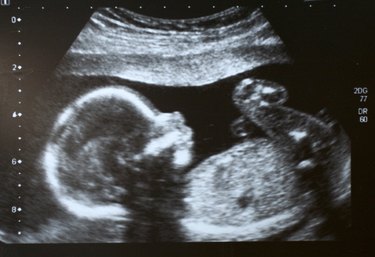
Your baby's placenta attaches to the inside of your uterus early in pregnancy. As the uterus grows, the placenta attachment site typically moves away from the cervix, or opening to the uterus, and toward the top, or fundus, of the uterus. However, if your placenta is close to the cervix during your pregnancy, you should take special precautions to reduce your risk of pregnancy complications. You should consult your physician or midwife about your exercise plans in pregnancy. You may need to restrict exercise during pregnancy, especially if you have a low-lying placenta.
Placentas
Video of the Day
Your placenta is an amazing organ that allows oxygen, nutrients and fluids to travel from your body to that of your baby. In addition, your placenta removes waste products from your baby's body. Your placenta completes your baby's lifeline. Your placenta securely attaches to the inside of your uterus. In the first half of your pregnancy, your uterus is small, and your placenta may be located close to your cervix. As your uterus grows and stretches, your placenta typically moves away from your cervix.
Video of the Day
Low-Lying Placenta
A low-lying placenta is located close to the cervix, but does not cover the cervical opening at all. An ultrasound can tell you if you have a low-lying placenta and, if so, the distance from the edge of your placenta to your cervix. This distance is measured in centimeters and you might have to have a vaginal ultrasound to obtain an accurate measurement. The risk of a low-lying placenta to you and your baby depends on many factors, including the distance of the placental edge from your cervix and how far along you are in your pregnancy.
Exercising
Exercise is an important part of a healthy pregnancy for most women. Unfortunately, if you have a low-lying placenta, your health care provider may caution you to limit or avoid exercise depending on the location of the placenta and how far along you are in your pregnancy. For example, if you are early in your pregnancy and the placental edge is several centimeters away from your cervix, you might be encouraged to walk or engage in light exercise, as the placental edge will likely migrate away from the cervix as your pregnancy progresses. However, if you are in your third trimester and your placenta is just a half-centimeter away from your cervix, your doctor might recommend that you avoid exercise.
Cautions
The difference between a low-lying placenta and a placenta previa is that a low-lying placenta is close to the cervix while a placenta previa touches or covers part or all of the cervix. An ultrasound can be useful in determining if your placenta is low-lying or a previa, but it is not fail-proof. If you have been told your placenta is low-lying, you might want to exercise caution and reduce your activity, refrain from intercourse and closely observe the area for vaginal bleeding in case the placenta touches or covers the cervix. Always discuss your particular diagnosis and precautions with your health care provider and seek emergency care with new or unexplained bleeding during pregnancy.